Metaphors, stories, and parables help us glimpse the unseeable, touch the unapproachable, and plumb the unfathomable. We learn from experience and example. As knowledge of the world grows more specialized, the cost and likelihood of isolation also grow. Samuel Matlack explains in an elegant essay that “if it mattes that we understand human experience as fully as we might, including how we shape our personal, moral, and political lives, then the hope that mathematical physics alone discloses ultimate reality is misguided” and we need “poetic forms of language” to bridge the gap. John O. McGinnis sees the same division and need for humanism at play physically and intellectually on university campuses.
While Matlack traces the centuries-long development of precise language at the expense of poetic, McGinnis looks back to C.P. Snow’s 1959 lecture “Two Cultures and the Scientific Revolution” to emphasize the need, among other things, for a core curriculum that “forces students to reason together in a common conversation [with the past] on campus.” This common conversation is important because, “Economics may create a framework for a sophisticated cost-benefit analysis, but only an understanding of the human condition, guided by the canon of its greatest achievements, can fill in the boxes for benefits and costs.” The scientific culture describes what is and provides tools for “transformation and mastery of the world.” The artistic, humanistic culture describes what should be and provides the exemplary backgroundd for “evaluation of the transformations and mastery of ourselves.”
Public policy debates often reflect this cultural conflict as much as anything else. One side can describe the mechanics of a policy and measure the outcomes according to its preferred metrics while dismissing the importance of “Little Timmy” anecdotes. The other can talk about the human suffering that tugs at a person’s heart and conscience while dismissing the mechanics, finances, and other challenges of crafting a response or implementing it. Both sides start with why, just as Simon Sinek suggests, but the rest of the question differs based on the questioner’s predisposition to head and science or heart and humanities.


